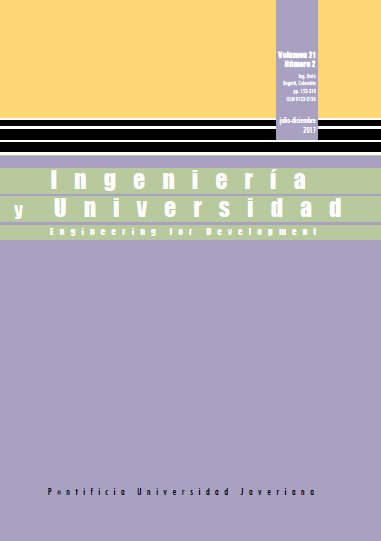Effects of incentives for renewable energy in Colombia
##plugins.themes.bootstrap3.article.details##
Introduction: This paper studies the potential effects of a new regulation to promote the development of renewable energy technologies in Colombia. Methods: This work establishes a methodology to include the effects of tax incentives in the calculation of the Levelized Cost of Electricity (LCOE). Two incentives are analyzed: tax deductions on the investment and accelerated depreciation on assets. Results: The first calculation shows up to 20% reduction in the LCOE; unfortunately, the regulation restricts small or new business from applying for all incentives. For this reason, two complementary mechanisms are proposed to allow small business ventures, such as forest biomass projects, to apply for incentives. As a result, a 30% reduction in the LCOE is obtained for photovoltaics (PV) and 15% for forest biomass. Conclusions: The deducted tax factor permits the direct computation of a tax-adjusted LCOE, avoiding extensive cash flow calculations. The high potential of biomass resources in Colombia and the proposed mechanisms can push LCOE prices lower than the grid parity cost in most isolated regions. This represents a great opportunity in Colombia because of the huge amount of biomass resources and the potential to create new job opportunities.
renewable energy, tax incentives, levelized cost of electricity, forest biomass, job creation., biomasa forestalenergías renovables, incentivos fiscales, costos nivelados de electricidad, creación de empleos
[2] P. Menanteau, D. Finon, and M.L. Lamie, “Prices versus quantities: choosing policies for promoting the development of renewable energy,” Energ. Policy, vol. 32, pp. 799-812, 2003.
[3] D. Jacobs, N. Marzolf N., J.R. Paredes, W. Rickerson, H. Flynn, C. Becker-Birck, and M. Solano-Peralta, “Analysis of renewable energy incentives in the Latin America and Caribbean region: The feed-in tariff case,” Energ. Policy, vol. 60, pp. 601-610, 2013.
[4] S. Reichelstein and M. Yorston, “The prospects for cost competitive solar PV power,” Energ. Policy, vol. 55, pp. 117-127, 2013.
[5] J. Ondraczek, N. Komendantova, and A. Patt, “WACC the dog: The effect of financing costs on the levelized cost of solar PV power,” Renew. Energ., vol. 75, pp. 888-898, 2015.
[6] F. Gulli and A. Lo Balbo, “The impact of intermittently renewable energy on Italian wholesale electricity prices: Additional benefits or additional costs?,” Energ. Policy, vol. 83, pp. 123-137, 2015.
[7] L. Fowler and J. Breen, “Political influences and financial incentives for renewable energy,” The Electricity Journal, vol. 27, pp. 74-84, 2014.
[8] N. Kilinc-Ata, “The evaluation of renewable energy policies across EU countries and US states: An econometric approach,” Energy for Sustainable Development, vol. 31, pp. 83-90, 2016.
[9] Z. Liu, W. Zhang, C. Zhao, and J. Yuan, “The economics of wind power in China and policy implications,” Energies, vol. 8, pp. 1529-1546, 2015.
[10] S. Romano, M. Cozzi, F. Di Napoli, and M. Viccaro, “Building agro-energy supply chains in the Basilicata region: Technical and economic evaluation of interchangeability between fossil and renewable energy sources,” Energies, vol. 6, pp. 5259-5282, 2013.
[11] UPME. Atlas de potencial hidroenergético de Colombia. Bogotá: Pontificia Universidad Javeriana, 2015. [Online]. Available: http://www.upme.gov.co/Atlas_Hidroenergetico/Atlas_p1-24.pdf. Accessed: 7 April 2016.
[12] I. Dyner, Y. Olaya, and C. J. Franco, “An enabling framework for wind power in Colombia: what are the lessons from Latin America,” in Diffusion of Renewable Energy Technologies: Case Studies of Enabling Frameworks in Developing Countries. Copenhagen: United Nations Development Program (UNDP), 2011, pp. 1–14.
[13] CORPOEMA. Formulación de un plan de desarrollo para las fuentes no convencionales de energía en Colombia. Bogotá: Unidad de Planeación Minero Energética (UPME), vol. 1, 2010, pp. 137-152. [Online]. Available: http://www.upme.gov.co/Sigic/DocumentosF/Vol_1_Plan_Desarrollo.pdf. Accessed: 15 April 2016.
[14] C.J. James, “What Colombia needs to jumpstart renewable energy investment,” Latin American Energy Review. March 2016. [Online]. Available: http://carlosstjames.com/renewable-energy/what-colombia-needs-to-jumpstart-renewable-energy-investment. Accessed: 24 May 2016.
[15] H. García, A. Corredor, L. Calderón, and M. Gómez, “Análisis costo beneficio de energías renovables no convencionales,” Fedesarrollo, Bogotá, Colombia, Oct 2013. [Online]. Available: http://www.fedesarrollo.org.co/wp-content/uploads/2011/08/WWF_Analisis-costo-beneficio-energias-renovables-no-convencionales-en-Colombia.pdf. Accessed on 27 May 2016.
[16] J. F. Pérez and L. F. Osorio, Forest Biomass as an Energy Alternative. Medellín: Universidadde Antioquia, 2014.
[17] Ley 1715/2014, de mayo 13, por medio de la cual se regula la integración de las energías renovables no convencionales al Sistema Energético Nacional. Diario Oficial 49.150.
[18] Grantham Research Institute on Climate Change and the Environment, Law 1715, Regulating the Integration and Promotion of Non-Conventional Renewable Energy to The National Energy System. London: The London School of Economics and Political Science. [Online]. Available: www.lse.ac.uk/GranthamInstitute/legislation/countries/colombia/#legislative. Accessed: 15 March 2016.
[19] A. Castillo-Ramírez, D. Mejía-Giraldo, and J. D. Giraldo-Ocampo, “Geospatial levelized cost of energy in Colombia: GeoLCOE,” in Proceedings 2015 IEEE PES Innovative Smart Grid Technologies Latin America (ISGT LATAM), Montevideo, Uruguay, Oct 2015; pp. 298-303.
[20] A. M. Vega, F. Santamaría, and E. Rivas, “Efficient home energy management based on incentives of the Colombian law 1715/2014,” Ing. Univ., vol. 20, pp. 259-275, 2016.
[21] A. Castillo-Ramírez, D. Mejía-Giraldo, and J.D. Molina-Castro, “Fiscal incentives impact for RETs in Colombia,” Energ Source., Part B: Economics, Planning, and Policy, vol. 0, pp. 1-6, 2017.
[22] J. Velásquez and R. Campo, “The Colombian electricity market and its impact in hydrothermal expansion,” in Proceedings of the Power and Energy Society General Meeting – Conversion and Delivery of Electrical Energy in the 21st Century, Pittsburgh, PA, USA, July 2008.
[23] L. De Castro, S. Oren, A. Riascos, and M. Bernal, “Transition to centralized unit commitment: An econometric analysis of Colombia`s experience”, Borradores de Economía, vol. 830, pp. 1-38, 2014.
[24] A.L. Farooquee and G. Shrimali, “Making renewable energy competitive in India: Reducing financing costs via a government-sponsored hedging facility,” Energ. Policy, vol. 95, pp. 518-528, 2016. [Online]. doi: https://doi.org/10.1016/j.enpol.2016.02.005


